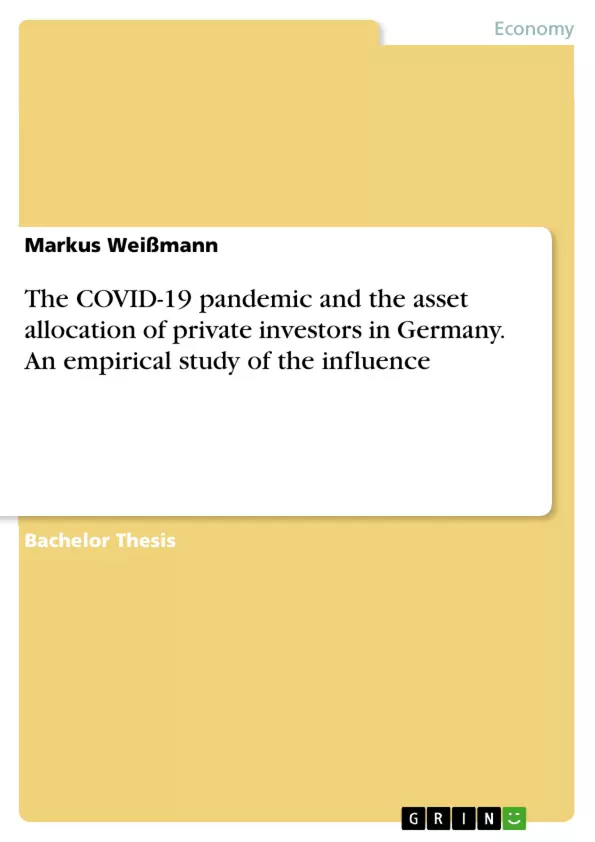This paper investigates, how private investors in Germany were influenced by the pandemic regarding their asset allocation. It presents a study that investigates the impact of the COVID-19 pandemic on the asset allocation of private investors in Germany. For this purpose, empirical data is collected by means of a survey and interesting results are recorded.
As the markets acted turbulent, it is expected that people have adapted to the situation and eventually have shifted between several investment instruments - also, that people were influenced in the form of changing focus regarding investor keywords like diversification, risk tolerance and others. Therefore, an empirical study with the help of a questionnaire is done.
Expectations for the future development of the investors are also addressed. In view of the limited time and resources available for the preparation of this scientific work, it is pointed out that external studies are also included in the search for results and new findings. The sum of the results of all studies including the survey conducted in this thesis is then finally used to answer the research topic or the question.
It feels like there is barely other news presented by the media as COVID-19 affects economy and social life very much in many if not all countries on our planet. That is not very surprising as the numbers of the worldwide production in the first quarter of 2020 decreased by about 15.5 percent, what could lead to a total decrease of 4.9 percent in 2020 as the DIW in Berlin estimates
Also, the current situation on the labor market, which is important for lots of people, does not reassure at all. When zooming in and only looking at Germany in this regard, it can be stated that the number of new gained employed persons decreases a lot comparing it to past quarters. This could lead to people not being able to pay their rent, credits and other bills what could have tremendous impact to other factor markets and social life of many people. Closed businesses, increased working from home and travel restrictions also caused a decrease of customer spending as the value of the first quarter of 2020 is around three percent lower than the previous quarter.
Inhaltsverzeichnis (Table of Contents)
- Introduction
- Topical situation
- Objectives and approach
- Pandemic
- Definition & historical events
- COVID-19
- World Health Organization
- Private investors
- Asset allocation
- Definition
- Tactical versus strategical asset allocation
- Tactical asset allocation
- Strategical asset allocation
- Portfolio selection
- Investment components
- Investment guide
- Investment instruments
- Selection
- Savings book
- Call money & fixed deposits
- Stocks
- Funds
- Gold
- Real estate
- Research
- Research question
- Research method
- Kinds of research
- Quantitative research vs. qualitative research
- Selection for the study
- Research instruments
- Questionnaire fundamentals, advantages & disadvantages
- Observation fundamentals, advantages & disadvantages
- Selection for the study
- Questionnaire – structure & procedure
- Evaluation
- Evaluation method
- Results evaluation
- Participants & survey period
- Experience & know-how
- Investor profile
- Previous influence of COVID-19
- Future influence expectations
- Interpretation
- Critical review & discussion
- Critical review
- Discussion
Zielsetzung und Themenschwerpunkte (Objectives and Key Themes)
This study aims to empirically analyze the influence of the COVID-19 pandemic on the asset allocation of private investors in Germany. The study investigates how the pandemic has impacted the investment decisions of private investors, considering their investment objectives, risk tolerance, and the specific investment instruments they utilize.
- The impact of the COVID-19 pandemic on investor behavior and decision-making
- The role of risk perception and risk aversion in shaping asset allocation strategies
- The influence of the pandemic on the choice of investment instruments
- The potential long-term implications of the pandemic on the asset allocation landscape
- The relationship between investor characteristics and their response to market volatility
Zusammenfassung der Kapitel (Chapter Summaries)
- Introduction: This chapter provides a general overview of the study, including the topical situation of the COVID-19 pandemic and its potential impact on private investors. It outlines the research objectives and the approach taken in this study.
- Pandemic: This chapter defines and explores the concept of a pandemic, examining historical events and the impact of the COVID-19 pandemic specifically. It also delves into the role of the World Health Organization in managing and responding to such crises.
- Private investors: This chapter explores the characteristics and motivations of private investors, setting the context for understanding their investment decisions.
- Asset allocation: This chapter defines and explains the concept of asset allocation, differentiating between tactical and strategic approaches. It further explores the process of portfolio selection and the key considerations involved.
- Investment components: This chapter delves into the specific investment instruments available to private investors, including savings books, call money & fixed deposits, stocks, funds, gold, and real estate. It provides a detailed overview of each instrument, highlighting its characteristics and potential benefits and risks.
- Research: This chapter outlines the research question and the chosen research method. It discusses different types of research, including quantitative and qualitative approaches, and explains the selection criteria used in the study. It also details the specific research instruments employed, such as questionnaires and observations, highlighting their advantages and disadvantages.
- Evaluation: This chapter focuses on the methods and results of the study. It describes the evaluation method used, outlines the key findings regarding the study's participants, and presents data on their experience, investment profile, and perceptions of the COVID-19 pandemic's influence on their investment decisions.
Schlüsselwörter (Keywords)
The central keywords and focus topics of this study include: COVID-19 pandemic, asset allocation, private investors, investment decision-making, risk perception, risk aversion, investment instruments, portfolio selection, market volatility, empirical research.
- Citar trabajo
- Markus Weißmann (Autor), 2021, The COVID-19 pandemic and the asset allocation of private investors in Germany. An empirical study of the influence, Múnich, GRIN Verlag, https://www.grin.com/document/998241



